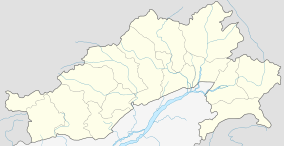Sessa Orchid Sanctuary
| Sessa Orchid Sanctuary | |
|---|---|
| wildlife sanctuary | |
|
| |
 Sessa Orchid Sanctuary  Sessa Orchid Sanctuary Location in Arunachal Pradesh, India | |
| Coordinates: 27°12′N 92°30′E / 27.2°N 92.5°ECoordinates: 27°12′N 92°30′E / 27.2°N 92.5°E | |
| Country |
|
| State | Arunachal Pradesh |
| District | West Kameng |
| Established | 1989 |
| Area | |
| • Total | 100 km2 (40 sq mi) |
| Languages | |
| • Official | English |
| Time zone | IST (UTC+5:30) |
| Vehicle registration | AR |
| Nearest city | Bomdila |
| IUCN category | IV |
| Governing body | Secretary (Political), Government of Arunachal Pradesh |
| Website:SESSA ORCHID SANCTUARY & NURSERY | |
Sessa Orchid Sanctuary is a 100 km2 protected area of India in the Himalayan foothills in Bhalukpong Forest Division of West Kameng District, Arunachal Pradesh. It conjoins Eaglenest Wildlife Sanctuary to the southwest. It is a part of the Kameng Protected Area Complex (KPAC), which is an Elephant Reserve. See map. The department of Environment & Forests has developed trekking routes for visitors to enjoy the natural habitats of orchids. There are deep gorges and valleys, high peaks and rugged terrain that are rewarding for nature lovers and adventure tourists. A nursery includes representative specimens of various orchid species of the sanctuary and a demonstration farm of Cymbidium hybrids for cut-flower production. Most of Sessa has traditionally been claimed by the Bugun tribe as part of their territory.
Geography and climate
Sessa and Eaglenest together occupy a rough east-west rectangle with Sessa occupying the north-east quadrant. The Bhalukpong-Bomdila highway (and Pakke immediately beyond) are its eastern boundary. It is bounded to the north by the Tenga River valley.[1] Altitude is 900 metres (2,953 ft) to 3,250 metres (10,663 ft).
Sessa and Eaglenest ridges rise to 3,250 metres (10,663 ft) and 2,700 metres (8,858 ft) respectively and are the first major barriers to the monsoon as it moves north from the plains of Assam. These ridges get over 3,000 millimetres (120 in) of rain on the southern slopes and about 1,500 millimetres (59 in) on the northern slopes.[2]
Sessa sanctuary is drained by the Tippi Naala (Tippi river) which joins the Kameng river at Tippi village on the Bhalukpong-Bomdila highway. Topographic map [3]
Sessa is part of the Kameng protected area complex (KPAC), the largest contiguous closed-canopy forest tract of Arunachal Pradesh, which includes Sessa, Eaglenest, Pakke, Nameri, and Sonai Rupai sanctuaries and associated reserved forest blocks. The Complex covers 3500 km2 in area and ranges from 100 metres (328 ft) to 3,300 metres (10,827 ft)3300m in altitude.[4]
Orchids
Sessa is noted for the occurrence of more than 200 orchid species with 5 new and endemic species.[5] Sub-tropical types include the genera Dendrobium, Bulbophyllum, Coelogyne, Eria, Phaius and Liparis. The sanctuary is unique in having 7 endemic species of saprotrophic orchids.[6] 12 rare species of different families were found in one study of the area.[7]
Orchid Research and Development Centre
The Government of Arunachal Pradesh in the late 1970s created a post of orchidologist in the Forest Department and in 1989 established the Orchid Research and Development Centre (ORDC) at Tipi, and the Sessa Orchid Sanctuary 20 km away. The ORDC is actively engaged in exploration and collection of orchid species, cultivation in orchidaria and gardens for their taxonomic study, conservation of rare and endangered species, creation of germplasm collections and multiplication of rare species through tissue culture techniques. The ORDC discovered the new species: Biermannia jainiana, Cleistoma tricallosum, Dendrobium kentrophyllum, Epipogium sessanum, Eria jengingensis, Eria lohitensis, Gastrodia arunachalenisis and Herminium longilonbatum.,[8][9]
Conservation
The Critical Ecosystem Partnership Fund (CEPF), a consortium of major international and regional organizations, has identified the Eastern Himalayan region around Arunachal Pradesh (Nepal, Bhutan and all of North-East India) as a critical global biodiversity rich area deserving of conservation focus. They identified the North-Bank Landscape (i.e. north bank of Brahmaputra, extending up the Eaglenest and Sessa slopes) and the Tawang region as worthy of particular focus.[10]
Sessa is within the Conservation International Himalaya Biodiversity Hotspot area.[11]
BirdLife International has designated Sessa and Eaglenest Sanctuaries as an Important Bird Area (IBA IN344), with Blyth's tragopan identified as a vulnerable species of the area.[12]
Visitor information
Visitors may contact the DFO Pakke WLS Division, Seijosa, East Kameng District or The Range Officer (WL), Sessa Orchid Sanctuary, Sessa, West Kameng District or the Asst. Orchidologist, Tipi Orchid Center, Tipi, West Kameng District.[13]
Notes
- ↑ Athreya Ramana M, Kartikeyan S., The Wildlife Sanctuaries in the Dafla Hills of Arunachal Pradesh Sessa Orchid Sanctuary
- ↑ Choudhury A. 2003: Birds of Eaglenest Wildlife Sanctuary and Sessa Orchid Sanctuary, Arunachal Pradesh, India. Forktail 19:1
- ↑ Army Map Service, Corp of Engineers (1955) Series U502, Sheet NG-46-2, Towang, India; Bhutan; China, topographic map 1:250,000, retrieved 10/2/2007 Topographic map
- ↑ Official website of West Kameng District (6/21/2007) Geography
- ↑ Govt. of Arunachal Pradesh, National Informatics Centre, Arunachal Pradesh State Unit, Orchid Tourism Orchid Tourism
- ↑ State Forest Research Institute, Department of Environment & Forests, Government of Arunachal Pradesh, retrieved 10/3/2007 SESSA ORCHID SANCTUARY & NURSERY, SESSA
- ↑ Padmawathe, R (2006) Edge related changes in species composition in vascular epiphyte in forests of Sessa Orchid Sanctuary, Arunachal Pradesh, Wildlife Institute of India, Dehradun, retrieved 10/3/2007 species composition
- ↑ ENVIS Centre Sikkim on Tourism, Physical Setting, retrieved 10/2/2007 ORCHIDS-The Jewel of Arunachal Pradesh
- ↑ State Forest Research Institute, Department of Environment & Forests, Government of Arunachal Pradesh,ORCHIDOLOGY-RESEARCH PAPERS
- ↑ Critical Ecosystem Partnership Fund, Project database Eastern Himalayas Region Strategic Directions
- ↑ Conservation International (2007) Himalaya - conservation action and protected areas, retrieved 10/1/2007 Himalaya - conservation action and protected areas
- ↑ BirdLife International (2006) BirdLife IBA Factsheet, retrieved 10/1/2007 IN344 Eaglenest and Sessa Sanctuaries
- ↑ The Hindu (9/3/2005) retrieved 10/3/07 Sessa Orchid Sanctuary
